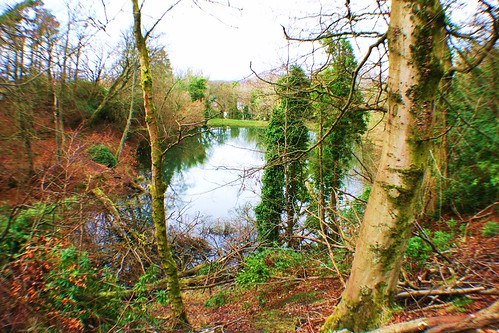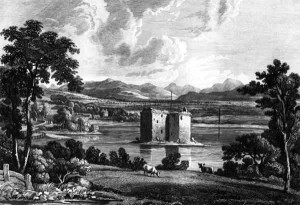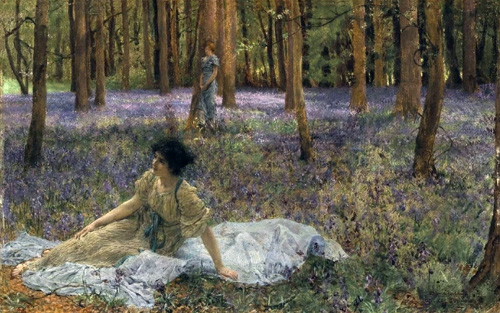Gloomy winter’s noo awa’ is a scottish song written by Robert Tannahill (1774 – 1810), poet and contemporary musician of Robert Burns. The piece is dated 1808, the melody is an ancient Scottish air, Lord Balgonie’s Favorite, arranged by his friend R.A. Smith.
Gloomy winter’s noo awa’ è un song scozzese scritto da Robert Tannahill (1774 – 1810), poeta e musicista contemporaneo di Robert Burns.
Il brano è datato 1808, la melodia è un’aria scozzese più antica, Lord Balgonie’s Favorite, arrangiata dall’amico R.A. Smith.
AN ENCHANTED LANDSCAPE: Gleniffer Braes
Gloomy winter’s noo awa’ describes an enchanted landscape that opens up to the eyes of the poet, while nature awakens under the golden caresses of the sun reinvigorated after the spring equinox. Unfortunately he lost his joy because during the winter his beloved maiden moved away from him.
The place so skilfully described is the current Gleniffer Braes Country Park that has not lost its charm of wild and unspoiled nature!
This song is found sometimes in the Celtic Christmas compilations, perhaps for that “gloomy winter” of the title that recalls the winter season, but the month descripted is not that of December, we are rather at the twilight of the Winter, in welcoming Spring: the wild bulbs that bloom, the cold waters that flow for the thaw, the beautiful sunny days.
Gloomy winter’s noo awa’ descrive un paesaggio incantato che si dischiude agli occhi del poeta, mentre la natura si risveglia sotto le carezze dorate del sole, rinvigorito dopo l’equinozio di primavera. Purtroppo egli ha perduto la gioia perchè durante l’inverno la fanciulla che amava si è allontanata da lui.
Il luogo descritto con tanta maestria è l’attuale Gleniffer Braes Country Park che non ha perso il suo fascino di natura selvaggia e incontaminata (una carrellata d’immagini scattate proprio in primavera)
Il brano si trova talvolta nelle compilation celtiche di Natale,forse per quel “Gloomy winter” del titolo che richiama la stagione invernale, però il mese descritto non è quello di dicembre, siamo piuttosto al crepuscolo dell’Inverno, che sta per andarsene e far posto alla primavera e i suoi primi timidi segnali: i bulbi selvatici che fioriscono, le acque che scorrono fredde per il disgelo, le belle giornate di sole.

Gleniffer Braes Country Park
Una brughiera scozzese con qualche bosco secolare residuale e aree agricole collinari, tanti sentieri tra cui quello dedicato ai luoghi preferiti da Robert Tannahill, abbondanza di ruscelli e cascate.
Vedute panoramiche su Paisley e sulla Clyde Valley fino al Ben Lomond.
continua in https://terreceltiche.altervista.org/the-braes-o-gleniffer/
Gloomy winter’s noo awa’
Tannahill Weavers, in “The Old Woman’s Dance” 1978
melancholic, hypnotic, almost whispered version, a fairy tale arrangement with the low and plaintive notes of the transverse flute. In the cover notes it is written”Note dripping icicle noises and delicately coughing blackbirds”
Emily Smith in The Complete Songs of Robert Tannahill Volume II (2010)
versione malinconica, ipnotica, quasi sussurrata, un arrangiamento fatato con le basse e lamentose note del flauto traverso. Nelle note di copertina è scritto “lo sgocciolare delle trine di ghiaccio e il delicato tossire dei merli.”
Tannahill Weavers, in “The Old Woman’s Dance” 1978
Sam Monaghan in The Tannahill Song Book 2000
I
Gloomy winter’s noo awa’,
Saft the westlan’ breezes blaw,
‘Mang the birks o’ Stanley shaw (1)
The mavis sings fu’ cheery, O.
II
Sweet the crawflower’s early bell (2)
Decks Gleniffer (3)’s dewy (4) dell,
Blooming like thy bonnie sel’,
My young, my artless deary, O.
III
Come, my lassie, let us stray
O’er Glenkilloch’s (5) sunny brae,
Blithely spend the gowden day
‘Midst joys that never weary, O.
IV
Towering o’er the Newton Woods (6),
Lav’rocks (7) fan the snaw-white clouds,
Siller saughs, wi’ downy buds,
Adorn the banks sae briery, O.
V
Round the sylvan fairy nooks,
Feathery breckans fringe the rocks,
‘Neath the brae the burnie (8) jouks,
And ilka thing is cheery, O.
VI
Trees may bud, and birds may sing
Flowers may bloom, and verdure spring,
Joy to me they canna’ bring,
Unless wi’ thee (9), my dearie, O.
NOTE 
1) Stanley Castle surrounded by hills and in pond, today only the vestiges of a tower remain. The Paisley forest was initially divided into three large areas called Stanely, Thornly and Fereneze, the north side later became Paisley Braes, or Braes of Gleniffer, the south side Fereneze Braes. “The lands of Stanely, part of the ridge of Paisley Braes, were granted by King Robert III. to Sir Robert Danyelston in 1392. One of his two daughters and co-heiresses married Sir Robert Maxwell, laird of Calderwood, in the parish of East Kilbride, and these lands, along with others, were allocated to Lady Calderwood. In the middle of the 15th century, the Maxwell family built on the lands a strong baronial residence, a massive piece of masonry, 40 feet high, which became well known by the name of Stanely Castle. The Maxwells continued in possession of the estate for several generations, and John Maxwell, in 1629, with consent of his son John, sold the estate to Jean Hamilton, dowager of Robert, fourth Lord Ross. It has con¬tinued in the Ross-Boyle families till the present time. The roof was taken off in 1714, when the “auld castle’s turrets” and the inside of the building were exposed to the inclemency of the weather. Stanely Castle, so hoary and grey, is now surrounded with a fine sheet of water,—the Reservoir of the Paisley Water Works.” (from here)
2) bluebell: the Wild Hyacinth, or Harebell (Hyacinthus Non Scriptus) with small blue-purple bells similar to the lilies of the valley that grow in the undergrowth, (not to be confused with the yellow Crowfoot (Ranunculus repens) so common in pasture fields, known by the common name of Buttercups. Another bluebell is the Campanula rotundifolia called Bluebell, or harebell: it is the official national flower of Scotland, the flower par excellence of fairies or witches, but it blooms in summer (from May) while the bell-shaped hyacinth blooms as early as April.
3) Today the Glennifer hill is included in a park, the Robertson Country Park, formed by wooded areas and the moor, on the ridge you can enjoy the panoramic view of Paisley and the Clyde valley
5) Killoch Glen: the south side of the ancient Paisley Forest, or the Fereneze Braes, beautiful valley full of streams.
6) The locations mentioned are located in the Center of Scotland near Paisley and are still places full of charm.
7) the lark is the herald of spring, with a melodious song that resounds in the air at the first light of dawn.
8) the area is rich in streams and spectacular waterfalls, in the Park the Tannahill Walkway and the Tannahill Well are dedicated to the poet
9) The beloved one to whom the poem inspired is Miss Elizabeth Wilson at the age of eighteen: the poet expresses the strength of a totalizing love that makes life and happiness impossible if not in the presence of the beloved, only now we realize that the poet has lost his love in winter, so the joy of the renewal of nature is precluded to him
Traduzione italiana di Cattia Salto
I
L’inverno tetro ora si allontana
leggeri soffiano i venti dell’ovest
tra le betulle del boschetto di Stanley
il tordo canta così allegramente O.
II
Soavi le prime campane dei giacinti
ricoprono la valle rigogliosa di Gleniffer
fiorendo come la mia bella,
cara giovane e spensierata O.
III
Vieni, ragazza, camminiamo
sulla soleggiata collina di Glenkilloch,
spensierati trascorriamo il giorno dorato
con rinnovata gioia O.
IV
In alto sopra i boschi di Newton
le allodole ammirano le nuvole nivee,
cespugli di salici con le gemme lanuginose,
adornano le rive così spinose O.
V
Tra i nascondigli delle fate silvestri,
le felci piumate orlano le rocce,
dal pendio il ruscello si tuffa
e tutto è allegria O.
VI
Rinverdiranno gli alberi, gli uccelli canteranno,
i fiori sbocceranno e spunterà l’erba,
ma gioia non potranno portarmi
a meno che io non sia con voi, mia cara O.
NOTE
1) Di Stanley Castle circondato dalle colline e in una polla d’acqua, oggi restano solo le vestigia di una torre. La foresta di Paisley inizialmente fu suddivisa in tre grandi aree chiamate Stanely, Thornly e Fereneze, il lato nord divenne poi Paisley Braes, ovvero Braes of Gleniffer, il lato sud Fereneze Braes. “Le terre di Stanely, parte della dorsale di Paisley Braes, furono concesse dal re Roberto III a Sir Robert Danyelston nel 1392. Una delle sue due figlie sposò Sir Robert Maxwell, laird di Calderwood, nella parrocchia di East Kilbride, e queste terre, insieme ad altre, furono assegnate a Lady Calderwood. A metà del XV secolo, la famiglia Maxwell costruì sulle terre una massiccia residenza baronale in pietra alta 40 piedi, che divenne famosa con il nome di Stanely Castle. I Maxwell continuarono a possedere la tenuta per diverse generazioni, e John Maxwell, nel 1629, con il consenso di suo figlio John, vendette la proprietà a Jean Hamilton, la vedova di Robert, il quarto Lord Ross. E’ rimasta alle famiglie di Ross-Boyle fino ai giorni nostri. Il tetto crollò 1714, quando le “auld castle’s turrets” e l’interno dell’edificio furono esposti alle intemperie del tempo. Il castello di Stanely, così canuto e grigio, è ora circondato da un sottile specchio d’acqua, il bacino idrico di Paisley.”
2) bluebell: il nome può indicare due diverse piante erbacee: il Giacinto a campanelle o giacinto di Spagna ( Hyacinthus Non Scriptus) delle piccole campanelle di colore blu-porpora simili ai mughetti che crescono nel sottobosco, da non confondersi con il Ranunculus repens di colore giallo e sono fiori di campo aperto conosciuti con il nome di Buttercups. Ma anche la Campanula rotundifolia ovvero la campanula soldanella, pianta dai fiori blu a forma di campana, appartenente alla famiglia delle Campanulaceae. E’ comunemente detta Campanelle (Bluebell, o harebell) ed è il fiore nazionale ufficiale della Scozia; è il fiore per antonomasia delle fate o delle streghe, ma fiorisce in estate (da maggio) mentre il giacinto a campanelle fiorisce già ad aprile .
3) Oggi la collina di Glennifer è compresa in un parco, the Robertson Country Park, formato da zone boschive e dalla brughiera, sul crinale si gode la vista panoramica di Paisley e della valle del Clyde.
4) dew letteralmente rugiadosa, bagnata dalla rugiada, a tradurla con un termine di allora sarebbe “rorida”, ma preferisco l’immagine figurata che denota freschezza giovanile, quindi “florida, rigogliosa”
5) il lato sud dell’antica Foresta di Paisley, ovvero il Fereneze Braes, bellissima vallata ricca di ruscelli.
6) Le località menzionate si trovano nel Centro della Scozia nei dintorni di Paisley e sono ancora luoghi ricchi di fascino.
7) l’allodola è un passerotto il cui canto melodioso risuona nell’aria fin dai primi giorni del nuovo sole, e già alle prime luci dell’alba
8) la zona è ricca di ruscelli e spettacolari cascate, nel Parco sono dedicati al poeta la Tannahill Walkway e il Tannahill Well.
9) La cara a cui la poesia s’ispira è Miss Elizabeth Wilson all’epoca diciottenne: il poeta esprime la forza di un amore totalizzante che rende impossibile la vita e la felicità se non in presenza dell’amata, solo ora ci accorgiamo che il poeta ha perduto l’amore della fanciulla in inverno, così la gioia del rinnovamento della natura è a lui preclusa

Gloomy winter / The Heart Asks Pleasure First
The tune could indeed be the melody composed by Alexander Campbell in 1783, called Lord Balgonie’s Favorite later renamed “As My Bride, Haste, Haste Away”.
Michael Nyman picked up the theme of the song for a superb arrangement-reworking entitled The Heart Asks Pleasure First / The Promise (for the film “The piano” 1993
Potrebbe trattarsi della melodia composta da Alexander Campbell nel 1783, detta Lord Balgonie’s Favorite più tardi rinominata As My Bride, Haste, Haste Away.
Michael Nyman riprese il tema del brano per un superbo arrangiamento-rielaborazione intitolata The Heart Asks Pleasure First / The Promise (per il film “Lezioni di piano” 1993.
Un brano che ha ricevuto allori e anche tributi da molti musicisti.
LINK
http://www.grianpress.com/Tannahill/TANNAHILL’S%20SONGS%205.htm
http://sangstories.webs.com/gloomywintersnooawa.htm
http://bluebellstrilogy.com/blog/tag/fairies/
http://www.tannahillweavers.com/lyrics/102lyr8.htm
https://thesession.org/tunes/6271

Gloomy Winter’s Noo Awa’
performed by Robert Lawrence & Jill Diana Greene
https://youtu.be/ypD3bnpMfEA
Thanks for contribution